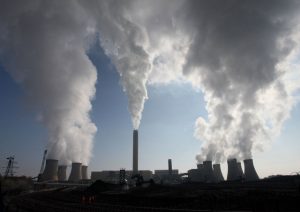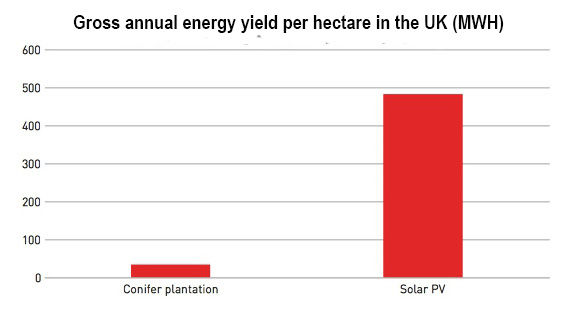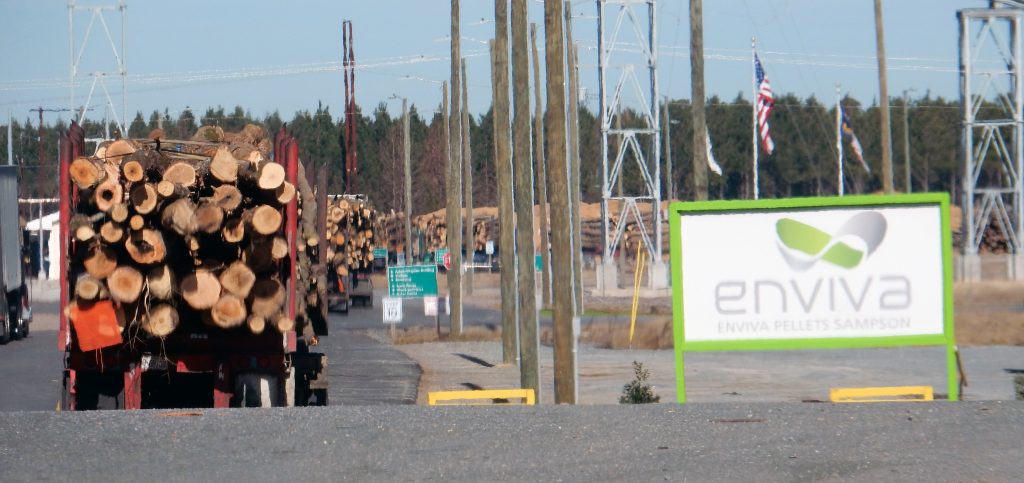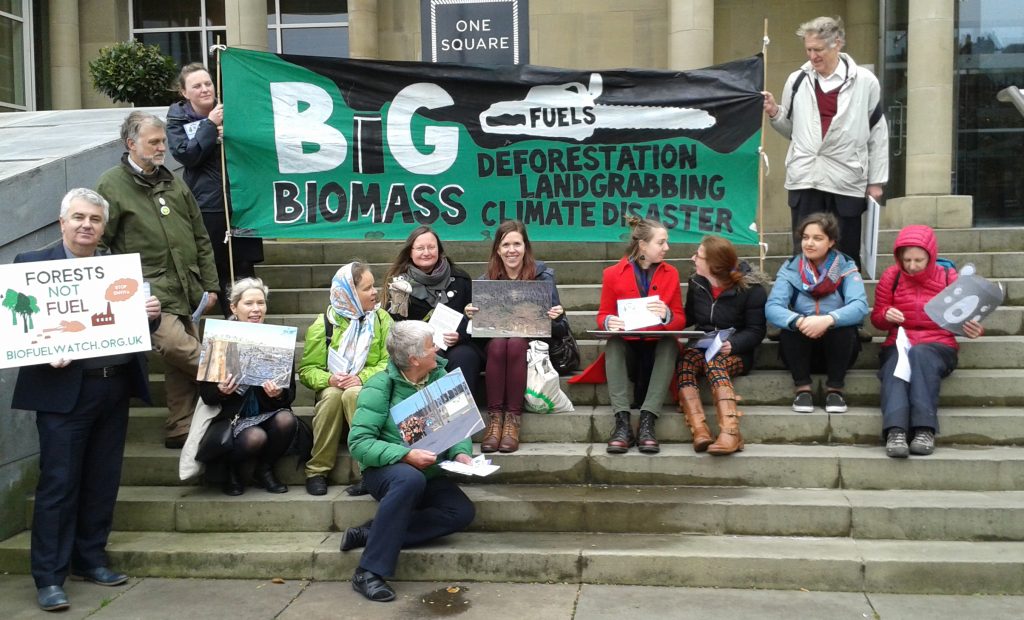What are the problems with big biomass?
In a nutshell – there are three problems:
1) It takes huge areas of land and huge quantities of wood to supply a tiny fraction of the energy we use.
2) Burning biomass emits CO2 to the atmosphere, just as burning fossil fuels does. Claims that all this CO2 can be ignored are based on politics, not science.
3) Burning biomass causes just as much harmful – and for some deadly – air pollution as burning coal.
1. Lots of land and wood for hardly any energy:

Drax Power Station, North Yorkshire. Photo: Andrew Whale, geograph.org.uk/p/2328563
In 2016, Drax Power Station burned pellets made from 13.2 million tonnes of wood1, which is the equivalent of 120% of the UK’s total wood production that year2. Burning far more than the UK’s total annual wood production supplied a mere 0.74% of the energy used in the UK that year! 3
Even if all that wood had been burned in extremely efficient combined heat and power plants rather than in Drax power station, it would still have contributed less than 1.5% of UK energy.
The reason why biomass has a huge land footprint is that plants are very inefficient at converting energy from the sun into chemical energy. Forests and other ecosystems constantly recycle carbon, nitrogen and many other nutrients. Only a small proportion of the solar radiation that falls on a leaf is used to sequester carbon in trees and soils . Even worse, the amount of energy contained in biomass that is converted to electricity in a power station is miniscule once we compare it to all the energy that goes into building a power station, maintaining and logging tree plantations, chipping wood or turning it into pellets, transporting it, and then burning it at 35% efficiency or less.
Biomass electricity is the least efficient way of using land to produce (renewable) energy – by a long stretch!
Here is a representation of the amount of energy which solar PV can generate from one hectare of land in the UK compared to the amount of energy contained in the annual growth of UK conifer plantations on one hectare. Note that the solar PV figure is very conservative and lower than what has been reported from projects in England.

If one looks at the actual amount of electricity generated from biomass versus solar PV from one hectare of land, the figures are even worse for biomass.
No, forestry and sawmill residues are not the answer:
Energy companies and pellet producers like to tell us that they are using “residues” for their woodchips and pellets – even if photos show truck after truck of whole logs entering the pellet plant or woodchip mill.

A truck full of whole logs entering one of Enviva’s wood processing facilities. Photo by Dogwood Alliance
In 2013, Timothy Searchinger from Princeton University calculated that, if the UK was to remove and burn all its forestry residues in power stations, those would supply a mere 0.9% of the UK’s electricity4. Because electricity accounts for just 17.5% of all the energy used in the UK5, this would translate into a mere 0.16 of total energy! And removing all residues, i.e. branches and leaves will deplete forest soils and result in them losing carbon and nutrients and in future trees growing less well. Even worse, a recent study shows that even burning US wood pellets that are made from genuine forestry residues will have a negative impact on carbon dioxide in the atmosphere for decades to come6.
2. No better for the climate than burning fossil fuels:
Burning biomass emits CO2 to the atmosphere, just as burning fossil fuels does. In fact, generating a unit of energy from wood emits between 3% and 50% more CO2 upfront than generating it from coal. Governments and industry tell us that we can ignore all of those CO2 emissions because new trees will absorb them in future. But this is a dangerous and flawed assumption, for several reasons, as many studies and reports show7:
• When trees are cut down for burning new ones will take decades to grow and absorb all the CO2 emitted again. At best, CO2 emitted from burning wood today still won’t be sequestered for at least a generation;
• Forests sequester CO2 year on year, both in wood and other vegetation, and in soils. For a forestry company, logging the equivalent of the annual growth in trees every year appears “sustainable” because the volume of wood in a plantation or forest isn’t diminished. But for the climate, this means that forests will no longer sequester any CO2 at all. At present, around 30% of all the CO2 that humans emit, mainly from burning fossil fuels, is sequestered by plants. If less CO2 is sequestered in plants, more will stay in the atmosphere, fuelling warming.
• The Paris Agreement commits Governments to trying to keep global warming to within 1.5ºC, but this will be impossible to achieve without a rapid phaseout of fossil fuel burning AND more CO2 being removed from the atmosphere. There is only one proven way of removing any CO2 from the atmosphere: Allowing natural ecosystems – including healthy soils – to flourish and regenerate, and helping restore them where necessary. If we want to have any hope of stabilising the climate, we need an end to fossil fuel burning as well allowing a lot more forests and other ecosystems to grow. Cutting down forests to replace some fossil fuels is completely the wrong answer.
• If forests are replaced with tree plantations, CO2 will be lost to the atmosphere forever because tree plantations contain much less carbon than forest ecosystems;
• Storing woodchips emits significant amounts of methane, and those methane emissions are not accounted for by anybody8.
In January 2018, a letter signed by 800 scientists was presented to the EU Parliament. It states: “Even if forests are allowed to regrow, using wood deliberately harvested for burning will increase carbon in the atmosphere and warming for decades to centuries –as many studies have shown –even when wood replaces coal, oil or natural gas. The reasons are fundamental and occur regardless of whether forest management is ‘sustainable’.”9
3. As polluting as coal
Burning wood in power stations is just as polluting as burning coal. It emits less of some pollutants (especially sulphur dioxide and mercury) but more of others (especially small particulates and Volatile Organic Compounds). Toxins emitted by biomass power plants are linked to respiratory and heart disease and strokes, and some are also linked to cancer and birth defects.
Furthermore, processing wood to pellets or woodchips often emits a lot of wood dust. Communities exposed to wood dust report higher incidents of respiratory and nasal problems and, furthermore, wood dust is a known carcinogen.
Click here to read our briefing about air pollution from biomass power stations.

Where do the wood pellets burned in the UK come from? How much wood are we talking about?
Right now, Drax is the only UK power station that burns imported wood pellets rather than domestic woodchips. In 2016, Drax burned 6.6 million tonnes of pellets (made from 13.2 million tonnes of wood). The majority of those pellets came from the southern US, with most of the remainder coming from Canada, Latvia and Estonia10. However, the mothballed Lynemouth coal power station is currently being converted to biomass and is expected to start operating later in 2018. And MGT Power (owned by Macquarie Group and the Danish pension fund PKA) is building a large new biomass power station at Tees Port which is to open in 2020. Both power stations are to burn 1.5 million tonnes of pellets annually, and both have entered into sourcing agreements with Enviva, Drax’s biggest external pellet supplier.
To find out more about wood pellets and how their trade damages forest ecosystems, click here.
- Tonnes of wood refers to tonnes of green wood, which is the weight of freshly cut wood. Drax burned 6.6 million tonnes of pellets in 2016 (drax.com/wp-content/uploads/2017/03/Drax-Group-plc-annual-report-and-accounts-2016-Smart-Energy-Solutions.pdf), with one tonne of pellets requiring around 2 tonnes of green wood
- Total UK wood production in 2016 was 11 million tonnes: forestry.gov.uk/forestry/infd-7aqdgc
- Drax generated 12.7 TWh of electricity from burning wood in 2016 (drax.com/wp-content/uploads/2017/03/Drax-Group-plc-annual-report-and-accounts-2016-Smart-Energy-Solutions.pdf). The UK’s total electricity use during that year was 303.8 TWh, however electricity contributed just 17.5% of the UK’s final energy demand. (gov.uk/government/uploads/system/uploads/attachment_data/file/633029/DUKES_2017_Press_Notice.pdf).
- Letter by Timothy Searchinger to Bernard Bulkin, Office of Renewable Energy, UK Department for Energy and Climate Change: Re Observations and Information Related to DECC Supplementary Statement of November 22, 2012 Regarding UK Bioenergy Strategy biofuelwatch.org.uk/2013/searchinger-letter-to-bulkin/
- gov.uk/government/uploads/system/uploads/attachment_data/file/633029/DUKES_2017_Press_Notice.pdf
- Not carbon neutral: Assessing the net emissions impact of residues burned for bioenergy, Mary S Booth 2018 Environ. Res. Lett. 13 035001, iopscience.iop.org/article/10.1088/1748-9326/aaac88/pdf
- See biofuelwatch.org.uk/biomass-resources/resources-on-biomass/ for a list of relevant scientific studies and reports.
- How certain are greenhouse gas reductions from bioenergy? Life cycle assessment and uncertainty analysis of wood pellet-to-electricity supply chains from forest residues, Mirjam Röder et.al., Biomass and Bioenergy, August 2015
- https://www.dropbox.com/s/l8sx5bl0h02x395/UPDATE%20800%20signatures_Scientist%20Letter%20on%20EU%20Forest%20Biomass.pdf?dl=0
- http://www.drax.com/wp-content/uploads/2017/03/Drax-Group-plc-annual-report-and-accounts-2016-Smart-Energy-Solutions.pdf
